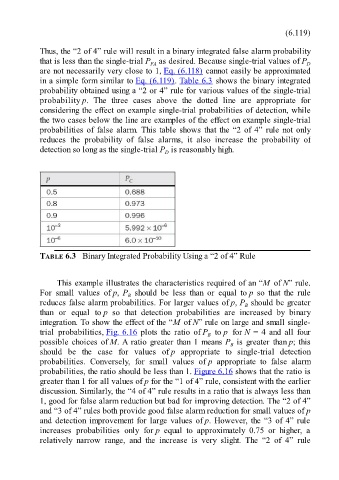Page 494 - Fundamentals of Radar Signal Processing
P. 494
(6.119)
Thus, the “2 of 4” rule will result in a binary integrated false alarm probability
that is less than the single-trial P as desired. Because single-trial values of P D
FA
are not necessarily very close to 1, Eq. (6.118) cannot easily be approximated
in a simple form similar to Eq. (6.119). Table 6.3 shows the binary integrated
probability obtained using a “2 or 4” rule for various values of the single-trial
probability p. The three cases above the dotted line are appropriate for
considering the effect on example single-trial probabilities of detection, while
the two cases below the line are examples of the effect on example single-trial
probabilities of false alarm. This table shows that the “2 of 4” rule not only
reduces the probability of false alarms, it also increase the probability of
detection so long as the single-trial P is reasonably high.
D
TABLE 6.3 Binary Integrated Probability Using a “2 of 4” Rule
This example illustrates the characteristics required of an “M of N” rule.
For small values of p, P should be less than or equal to p so that the rule
B
reduces false alarm probabilities. For larger values of p, P should be greater
B
than or equal to p so that detection probabilities are increased by binary
integration. To show the effect of the “M of N” rule on large and small single-
trial probabilities, Fig. 6.16 plots the ratio of P to p for N = 4 and all four
B
possible choices of M. A ratio greater than 1 means P is greater than p; this
B
should be the case for values of p appropriate to single-trial detection
probabilities. Conversely, for small values of p appropriate to false alarm
probabilities, the ratio should be less than 1. Figure 6.16 shows that the ratio is
greater than 1 for all values of p for the “1 of 4” rule, consistent with the earlier
discussion. Similarly, the “4 of 4” rule results in a ratio that is always less than
1, good for false alarm reduction but bad for improving detection. The “2 of 4”
and “3 of 4” rules both provide good false alarm reduction for small values of p
and detection improvement for large values of p. However, the “3 of 4” rule
increases probabilities only for p equal to approximately 0.75 or higher, a
relatively narrow range, and the increase is very slight. The “2 of 4” rule

